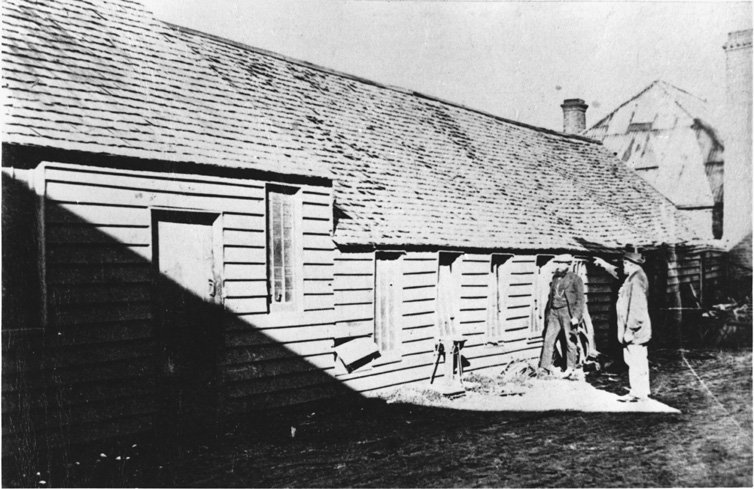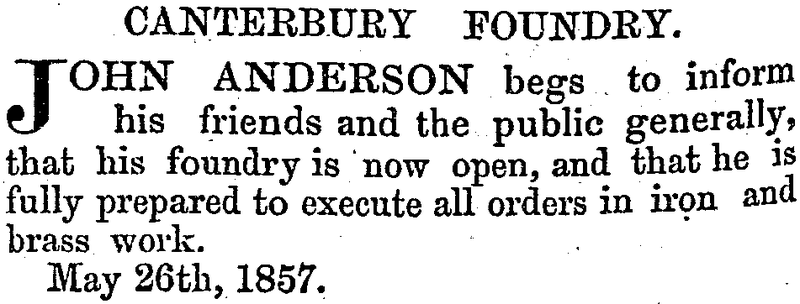From a modest blacksmithing practice, Andersons grew to become a diverse company manufacturing all manner of metal machinery and structures, from steam boilers to rail bridges. Established in the 1850s, Andersons has made a significant contribution to the development of New Zealand Industrial manufacture over more than 100 years of operation.
Early years
John Anderson (1820 – 1897), his wife, Jane, and young son, John, emigrated from Scotland in 1850. They settled in Canterbury and Anderson set up business as a blacksmith, taking out premises on Oxford Terrace, and later, on Cashel Street, in central Christchurch.

John Anderson's old workshop, Cashel Street, circa 1860. Canterbury Museum, Barker album 1, p 41. Accession Number 1957.13.3. https://collection.canterburymuseum.com/objects/191385. Licensed under Creative Commons (CC BY-NC 4.0).
In 1857, the business expanded to include a foundry. Andersons also became the import agent for a range of machinery including traction engines. In the 1860s, Andersons began to build steam boilers and equipment to process flax, wool and livestock.

Lyttelton Times, 8 August 1857,p6
Full steam ahead
The 1870s saw the company awarded a number of government contracts for the construction of rail lines and bridges, including the Rakaia and Ashburton Forks railway to Methven (1878–1879).
In 1881, John Anderson retired and handed over the running of the business to his sons, Andrew and John. The firm continued to prosper, completing contracts for the Beaumont road bridge, South Otago (1886-87) and the section of the North Island Main Trunk Railway from Te Kuiti to the Mokau River crossing, including the Waitete steel viaduct (1887).
In 1887, Andersons opened a workshop at Lyttelton. Here, the company constructed and repaired ships and built steam-powered dredges. The dredges were a valuable tool in the extraction of alluvial gold and in harbour development projects.
Twentieth Century
Andersons continued strong into the twentieth century, adapting their steam technology to diesel and electric.
In 1903, J & A Andersons became a private limited liability company, Andersons Limited.
Andersons continued to expand their product catalogue, growing to include road rollers, excavators, laundry machinery, stone crushers, petrol storage tanks, rivetted penstock pipe, combined churn and butter-worker machines, tilting-drum concrete mixers, automatic stokers, water pumps, wool-scouring bowls, wool dryers and an oil engine of their own design.
By 1920, the company was again ready to expand and moved to new premises at Woolston, conveniently located on the Christchurch to Lyttelton railway line.
During World War II, Andersons filled contracts for the New Zealand Defence Force, making grenade bodies, machine gun carriers and radar height structures. Post-war, Andersons gained work on hydroelectric projects, making scroll cases, draft tubes, and intake and spillway gates.
Many Andersons-trained apprentices went on to start their own businesses, some of which remain in Christchurch to this day. Andersons merged with Mason Brothers Ltd in 1964, and then closed in 1986 when the dominant home market became eroded following the lifting of import quotas.
Legacy
From small beginnings, Andersons adapted and grew to meet the needs of New Zealand’s developing industry. The company embraced technological change and developed a broad range of products and skills. Andersons employed and trained many people, bringing local expertise to infrastructure projects, product design and construction; a contribution still evident today.
Related Record entries
Oamaru Borough Council public water supply race (1877-1880)
Beaumont Bridge, Clutha (1886-87)
More information
References
Anderson, H. B. The day's run. Christchurch: H. Anderson, 1977.
[Anderson, H. B.] 100 years: being an account of the founding, development and progress of Andersons, 1850-1950. Christchurch: Caxton, 1950.
Batchelor, Brian D. and, Richard H Robinson. “Anderson Oil Engines”, Country Life (NZ) Ltd, 1992.
Furkert, F. W. Early New Zealand Engineers. Wellington: Reed, 1953, pp93-95
Lowe, Peter. “Anderson, John”, Dictionary of New Zealand Biography, first published in 1990. Te Ara - the Encyclopedia of New Zealand, https://teara.govt.nz/en/biographies/1a6/anderson-john (accessed 29 March 2019).
Wright, Matthew. Big Ideas: 100 Wonders of New Zealand Engineering. Auckland: Random House, 2009.
